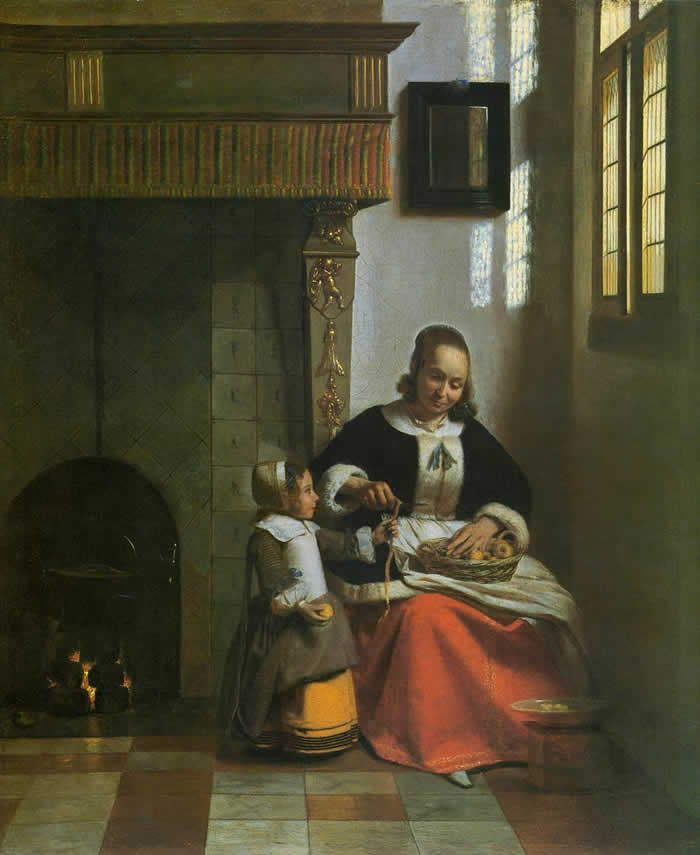Woman Peeling Apples
Pieter de Hooghc. 1663
Oil on canvas, 71 x 54 cm.
Wallace Collection, London
click here for more Pieter de Hoogh images.

Pieter Heindricksz. de HOOCH
Rotterdam 1629 Amsterdam after 1683 (?)
Pieter de Hooch (who often spelled his name 'de Hoogh' in his earlier days) was baptized in Rotterdam on 20 December, 1629. He was the son of a stonemason. He was probably the pupil of Nicolaes Berchem, the landscape painter, in Haarlem, though his own earliest pieces are barrack-room scenes recalling those of Codde and ter Borch. In 1653 he is recorded in the service of a cloth-merchant who lived in Delft; De Hooch is called a servant and painter. In May 1654 he married and settled in Delft, and in September the following year he entered the Delft guild. Which of the Delft painters he knew well is not recorded: he may have become acquainted with Carel Fabritius before the fateful explosion of October 1654 in which the latter was killed. It was in those years in Delft that De Hooch painted his best works, works that establish him as the great poet of the Dutch domestic interior, the rival of that other great painter from Delft, Johannes Vermeer. Unlike Vermeer, whose preferred subject was a solitary woman in the corner of a room, de Hoogh did show family life. Though men seldom intrude, his interiors are occupied with the activities of the home; his women are wives and mothers, mistresses of the house-hold, accompanied by children and servants. The true subject of de Hooch's Delft paintings, however, is the Dutch house itself, its spaces and vistas, its open doors and windows through which the world is seen. These canvases offer a microcosm of Holland in the seventeenth century. At some time between 1660 and 1663, De Hooch moved to Amsterdam, and his work, perhaps under the influence of work by Maes and de Witte, began to deteriorate. There is evidence that he continued to live in Amsterdam until 1670, and there are paintings dated as late as 1684, but the year and place of his death are not known.
from:
The Age of Rembrandt and Vermeer, John Nash, London, 1972
- Willem van Aelst (2)
- Balthasar van der Ast (6)
- Hendrick Avercamp (3)
- Dirck van Baburen (7)
- Jacob Adriaenz. Backer (3)
- David Bailly
- Ludolf Bakhuysen
- Bartholomeus van Bassen
- Cornelis Bega
- Gerrit Berckheyde (2)
- Gillis Gillisz de Bergh
- Jan van Bijlert (7)
- Jan de Bisschop (2)
- Abraham Bloemaert (4)
- Pieter De Bloot
- Ferdinand Bol (3)
- Hans Bollinger
- Paulus Bor (2)
- Ambrosio Bosschaert (7)
- Jan Both
- Leonaert Bramer (4)
- Salomon de Bray (2)
- Quiringh van Brekelenkam (4)
- Jan Gerritszoon van Bronchorst (2)
- Adriaen Brouwer (5)
- Hendrick ter Brugghen (6)
- Hendrick van der Burch (5)
- Willem Buytewech (6)
- Abraham van Calraet (2)
- Jacob van Campen
- Jan van de Cappelle(3)
- Pieter Claesz (4)
- Pieter Codde (6)
- Adriaen Coorte (9)
- Josse van Craesbeeck (2)
- Aelbert Cuyp (6)
- Philip van Dijk
- Gerrit Dou (10)
- Willem Drost (2)
- Hendrick Dubbels
- Jacob Duck (4)
- Karel Dujardin (3)
- Willem Duyster (5)
- Gerbrand van den Eeckhout
- Pieter Jansens Elinga
- Cesar van Everdingen (5)
- Allaert van Everdingen
- Carel Fabritius (5)
- Goveart Flinck
- Frans Francken the Younger
- Aert de Gelder
- Cornelis Gijsbrechts
- Jan van Goyen (6)
- Frans Hals (3)
- Dirck Hals (5)
- Jan Davidsz. Heem (6)
- Maerten van Heemskerck
- Bartholomeus van der Helst (4)
- Jan van der Heyden (8)
- Meyndert Hobbema (3)
- Gerard van Honthorst (8)
- Pieter de Hooch (12)
- Van Hoogstraten (9)
- Gerard Houckgeest (4)
- Jan van Huysum (3)
- Willem Kalf (4)
- Jan van Kessel
- Philip Koninck (2)
- Gérard de Lairesse (5)
- Pieter Lastman
- Judith Jansdochter Leyster (5)
- Jan Lievens (4)
- Jacob van Loo (7)
- Nicolaes Maes (9)
- Cornelis de Man (5)
- Gabriel Metsu (12)
- Michiel Janz. van Mierevelt (3)
- Frans van Mieris (8)
- Jan Miense Molenaer (5)
- Pieter Molijn (2)
- Paulus Moreelse (2)
- Pieter Mulier
- Michiel van Musscher (5)
- Aert van der Neer (3)
- Eglon van der Neer (3)
- Caspar Netscher (5)
- Jacob Ochervelt (8)
- Jacob van Oost (2)
- Adriaen van Ostade (5)
- Antonie Palamedesz (6)
- Adam Pijnacker (5)
- Egbert van der Poel (2)
- Jan Porcellis (4)
- Pieter Symonz. Potter
- Paulus Potter (7)
- Pieter Jansz. Quast (2)
- Rembrandt van Rijn (complete oeuvre)
- Jacob van Ruisdael (8)
- Solomon van Ruisdael (7)
- Rachel Ruysch (2)
- Pieter Saenredam (3)
- Godfried Schalcken (6)
- Hercules Segers (2)
- Hendrick Sorg (4)
- Jan Steen (8)
- Harmen Steenwyck (3)
- Matthias Stom (2)
- Michael Sweerts (6)
- David Teniers the Younger
- Gerrit ter Borch (15)
- Willem van de Velde (7)
- Jacob van Velsen
- Johannes Verkolje (2)
- Jan Cornelisz Verspronck (4)
- Abraham de Verwer
- Simon de Vlieger
- Hendrick van Vliet (2)
- Daniel Vosmaer (4)
- Jacobus Vrel (8)
- Jacob van Walscapelle (2)
- Jan Baptist Weenix (2)
- Jan Wijnants (3)
- Emanuel de Witte (6)
- Philips Wouwermans (2)
 or anything else that isn't working as it should be, I'd love to hear it! Please write me at:
or anything else that isn't working as it should be, I'd love to hear it! Please write me at: